TOYOTA RAV4 PHEV 2021 Owners Manual
Manufacturer: TOYOTA, Model Year: 2021, Model line: RAV4 PHEV, Model: TOYOTA RAV4 PHEV 2021Pages: 666, PDF Size: 161.28 MB
Page 591 of 666
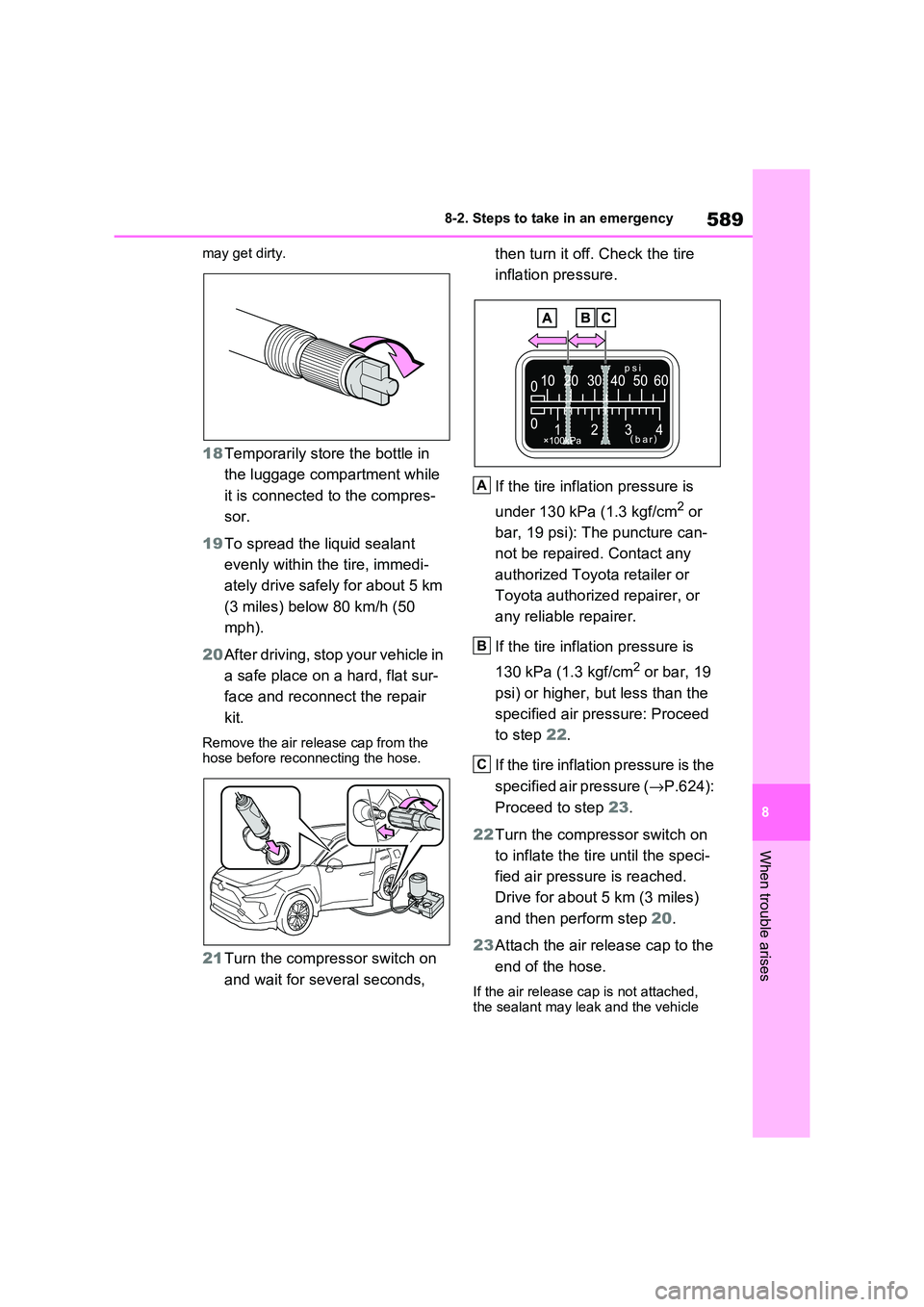
589
8
8-2. Steps to take in an emergency
When trouble arises
may get dirty.
18 Temporarily store the bottle in
the luggage compartment while
it is connected to the compres -
sor.
19 To spread the liquid sealant
evenly within the tire, immedi -
ately drive safely for about 5 km
(3 miles) below 80 km/h (50
mph).
20 After driving, stop your vehicle in
a safe place on a hard, flat sur-
face and reconnect the repair
kit.
Remove the air rel ease cap from the hose before reconnecting the hose.
21 Turn the compressor switch on
and wait for several seconds,
then turn it off. Check the tire
inflation pressure.
If the tire infla tion pressure is
under 130 kPa (1.3 kgf/cm2 or
bar, 19 psi): The puncture can -
not be repaired . Contact any
authorized Toyota retailer or
Toyota authorized repairer, or
any reliable repairer.
If the tire infla tion pressure is
130 kPa (1.3 kgf/cm2 or bar, 19
psi) or higher, but less than the
specified air pr essure: Proceed
to step 22.
If the tire inflation pressure is the
specified air pressure ( →P.624):
Proceed to step 23.
22 Turn the compressor switch on
to inflate the tire until the speci -
fied air pressure is reached.
Drive for about 5 km (3 miles)
and then perform step 20.
23 Attach the air release cap to the
end of the hose.
If the air release c ap is not attached,
the sealant may leak and the vehicle
A
B
C
Page 592 of 666
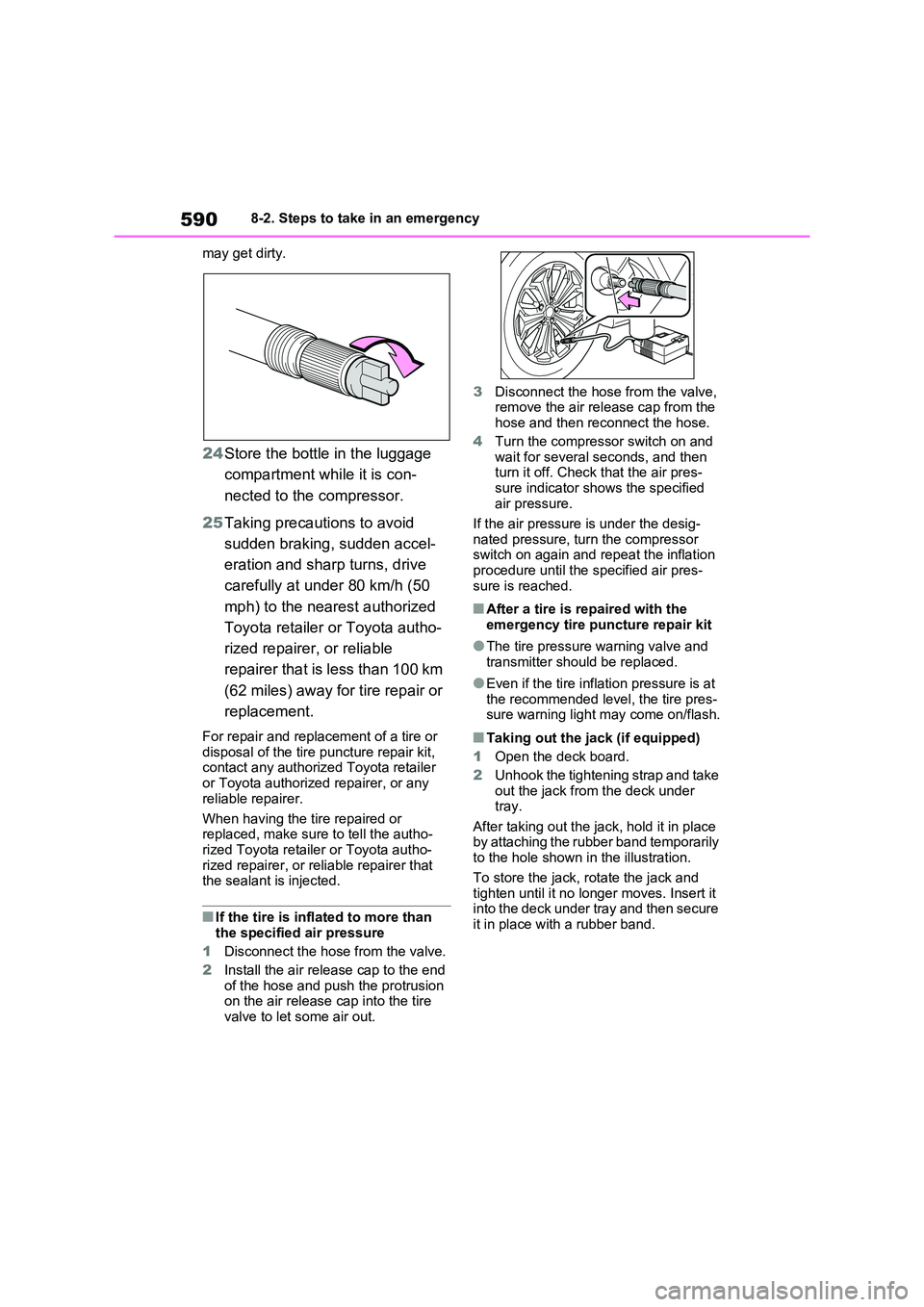
5908-2. Steps to take in an emergency
may get dirty.
24 Store the bottle in the luggage
compartment while it is con -
nected to the compressor.
25 Taking precautions to avoid
sudden braking, sudden accel -
eration and sharp turns, drive
carefully at under 80 km/h (50
mph) to the nearest authorized
Toyota retailer or Toyota autho -
rized repairer, or reliable
repairer that is less than 100 km
(62 miles) away for tire repair or
replacement.
For repair and replacement of a tire or
disposal of the tire puncture repair kit, contact any authoriz ed Toyota retailer
or Toyota authorized repairer, or any
reliable repairer.
When having the tire repaired or
replaced, make sure to tell the autho -
rized Toyota retaile r or Toyota autho- rized repairer, or reliable repairer that
the sealant is injected.
■If the tire is inflated to more than
the specified air pressure
1 Disconnect the hose from the valve.
2 Install the air release cap to the end of the hose and push the protrusion
on the air release cap into the tire
valve to let some air out.
3 Disconnect the hose from the valve, remove the air rel ease cap from the
hose and then reconnect the hose.
4 Turn the compressor switch on and
wait for several s econds, and then turn it off. Check that the air pres -
sure indicator shows the specified
air pressure.
If the air pressure is under the desig -
nated pressure, turn the compressor
switch on again and repeat the inflation procedure until the specified air pres-
sure is reached.
■After a tire is re paired with the
emergency tire puncture repair kit
●The tire pressure warning valve and
transmitter should be replaced.
●Even if the tire inflat ion pressure is at
the recommended level, the tire pres - sure warning light may come on/flash.
■Taking out the jack (if equipped)
1 Open the deck board.
2 Unhook the tightening strap and take out the jack from the deck under
tray.
After taking out the ja ck, hold it in place by attaching the rubber band temporarily
to the hole shown in the illustration.
To store the jack, rotate the jack and tighten until it no longer moves. Insert it
into the deck under tray and then secure
it in place with a rubber band.
Page 593 of 666
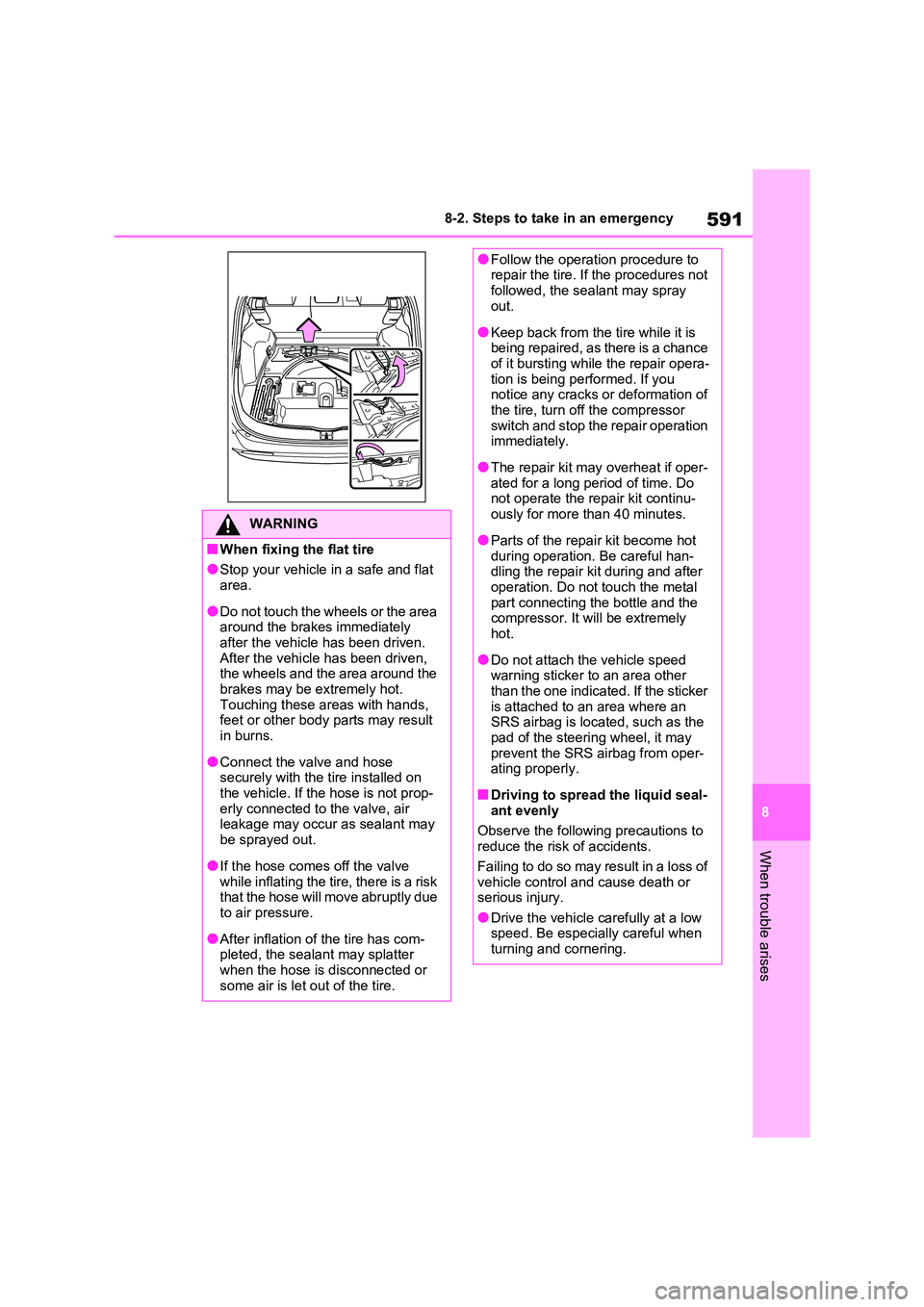
591
8
8-2. Steps to take in an emergency
When trouble arises
WARNING
■When fixing the flat tire
●Stop your vehicle in a safe and flat area.
●Do not touch the wheels or the area
around the brakes immediately after the vehicle has been driven.
After the vehicle has been driven,
the wheels and the area around the brakes may be extremely hot.
Touching these areas with hands,
feet or other body parts may result in burns.
●Connect the valve and hose securely with the tire installed on
the vehicle. If the hose is not prop-
erly connected to the valve, air leakage may occur as sealant may
be sprayed out.
●If the hose comes off the valve
while inflating the tire, there is a risk
that the hose will move abruptly due to air pressure.
●After inflation of the tire has com - pleted, the sealant may splatter
when the hose is disconnected or
some air is let out of the tire.
●Follow the operation procedure to repair the tire. If the procedures not
followed, the seal ant may spray
out.
●Keep back from the tire while it is
being repaired, as there is a chance of it bursting while the repair opera -
tion is being performed. If you
notice any cracks or deformation of the tire, turn off the compressor
switch and stop the repair operation
immediately.
●The repair kit may overheat if oper-
ated for a long period of time. Do not operate the repair kit continu -
ously for more than 40 minutes.
●Parts of the repair kit become hot
during operation. Be careful han -
dling the repair kit during and after operation. Do not touch the metal
part connecting the bottle and the
compressor. It will be extremely hot.
●Do not attach the vehicle speed warning sticker to an area other
than the one indicated. If the sticker
is attached to an area where an SRS airbag is located, such as the
pad of the steering wheel, it may
prevent the SRS airbag from oper - ating properly.
■Driving to spread the liquid seal- ant evenly
Observe the following precautions to
reduce the risk of accidents.
Failing to do so may result in a loss of
vehicle control and cause death or
serious injury.
●Drive the vehicle carefully at a low speed. Be especially careful when
turning and cornering.
Page 594 of 666
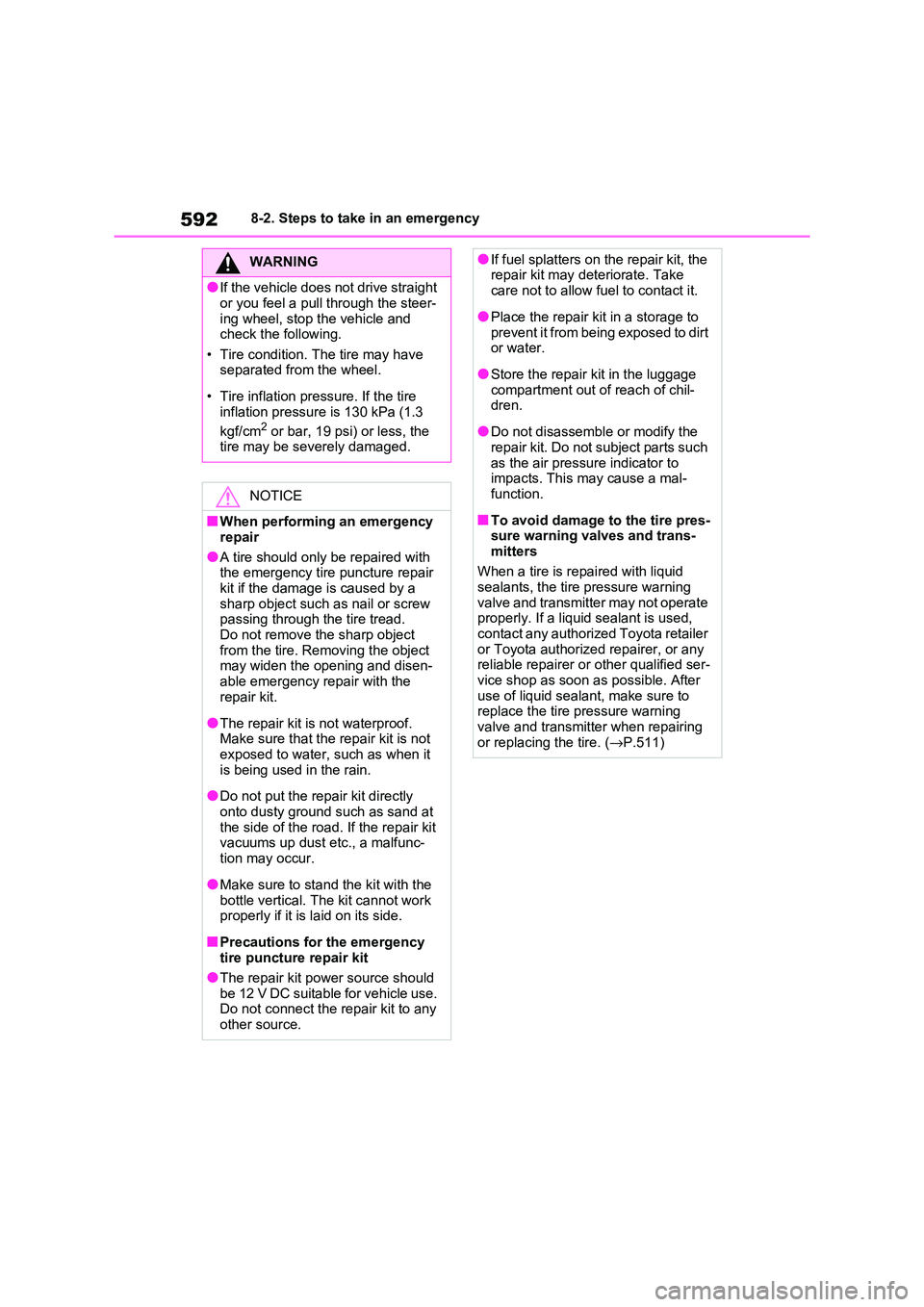
5928-2. Steps to take in an emergency
WARNING
●If the vehicle does not drive straight
or you feel a pull through the steer -
ing wheel, stop the vehicle and check the following.
• Tire condition. The tire may have
separated from the wheel.
• Tire inflation pressure. If the tire
inflation pressure is 130 kPa (1.3
kgf/cm2 or bar, 19 psi) or less, the tire may be severely damaged.
NOTICE
■When performing an emergency
repair
●A tire should only be repaired with
the emergency tire puncture repair
kit if the damage is caused by a sharp object such as nail or screw
passing through the tire tread.
Do not remove the sharp object from the tire. Removing the object
may widen the opening and disen -
able emergency repair with the
repair kit.
●The repair kit is not waterproof.
Make sure that the repair kit is not exposed to water, s uch as when it
is being used in the rain.
●Do not put the repa ir kit directly
onto dusty ground such as sand at
the side of the road. If the repair kit vacuums up dust etc., a malfunc -
tion may occur.
●Make sure to stand the kit with the
bottle vertical. The kit cannot work
properly if it is laid on its side.
■Precautions for the emergency
tire puncture repair kit
●The repair kit power source should
be 12 V DC suitable for vehicle use.
Do not connect the repair kit to any other source.
●If fuel splatters on the repair kit, the repair kit may det eriorate. Take
care not to allow fu el to contact it.
●Place the repair kit in a storage to
prevent it from being exposed to dirt
or water.
●Store the repair ki t in the luggage
compartment out of reach of chil - dren.
●Do not disassemble or modify the repair kit. Do not subject parts such
as the air pressure indicator to
impacts. This ma y cause a mal- function.
■To avoid damage to the tire pres - sure warning valves and trans -
mitters
When a tire is repa ired with liquid sealants, the tire pressure warning
valve and transmitter may not operate
properly. If a liquid sealant is used, contact any authorized Toyota retailer
or Toyota authoriz ed repairer, or any
reliable repairer or other qualified ser - vice shop as soon as possible. After
use of liquid sealant, make sure to
replace the tire pressure warning valve and transmitter when repairing
or replacing the tire. ( →P.511)
Page 595 of 666
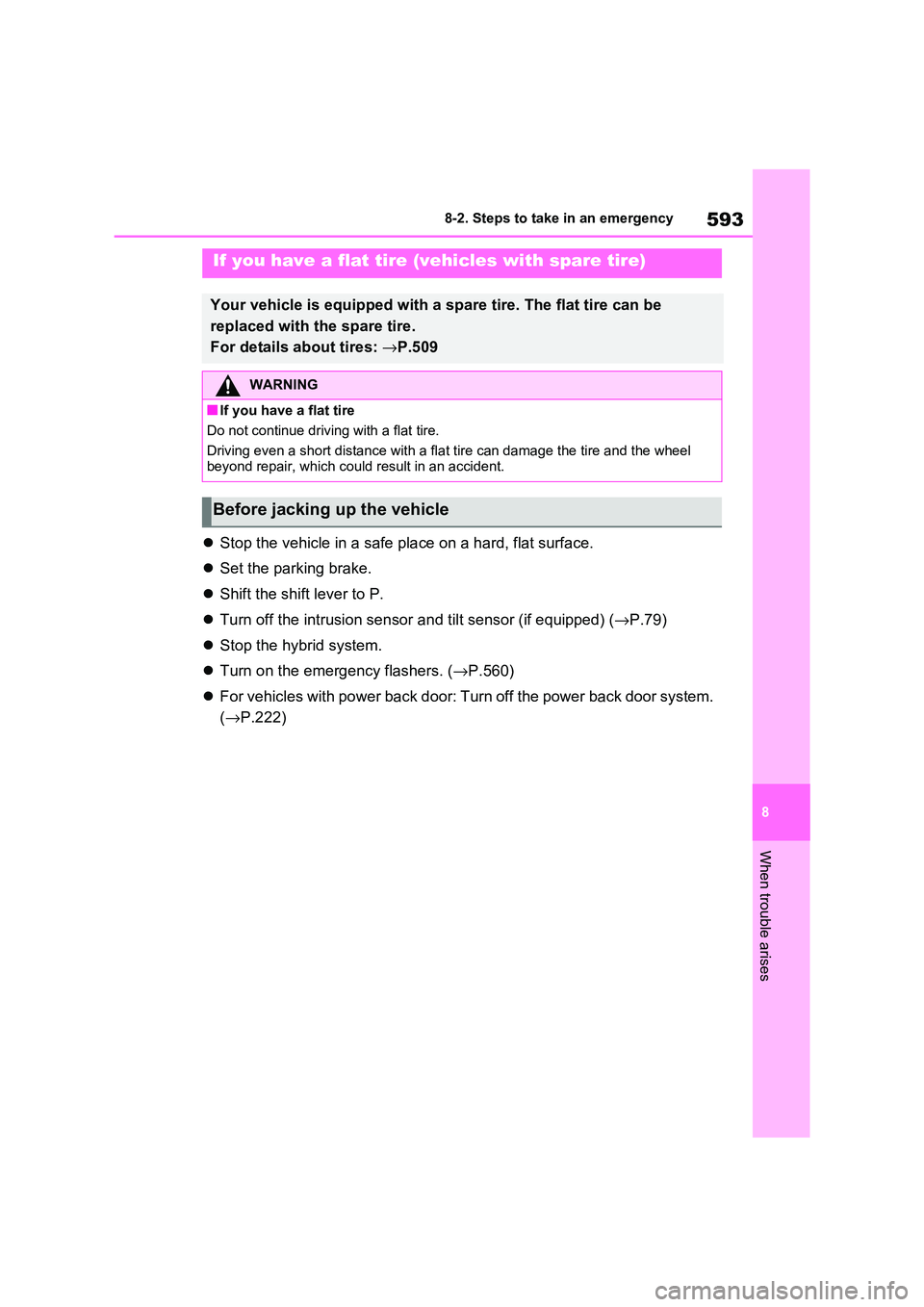
593
8
8-2. Steps to take in an emergency
When trouble arises
Stop the vehicle in a safe place on a hard, flat surface.
Set the parking brake.
Shift the shift lever to P.
Turn off the intrusion sensor and tilt sensor (if equipped) (→P.79)
Stop the hybrid system.
Turn on the emergency flashers. (→P.560)
For vehicles with power back door: Turn off the power back door system.
( →P.222)
If you have a flat tire (vehicles with spare tire)
Your vehicle is equipped with a spare tire. The flat tire can be
replaced with the spare tire.
For details about tires: →P.509
WARNING
■If you have a flat tire
Do not continue drivi ng with a flat tire.
Driving even a short distance wit h a flat tire can damage the tire and the wheel beyond repair, which could result in an accident.
Before jacking up the vehicle
Page 596 of 666
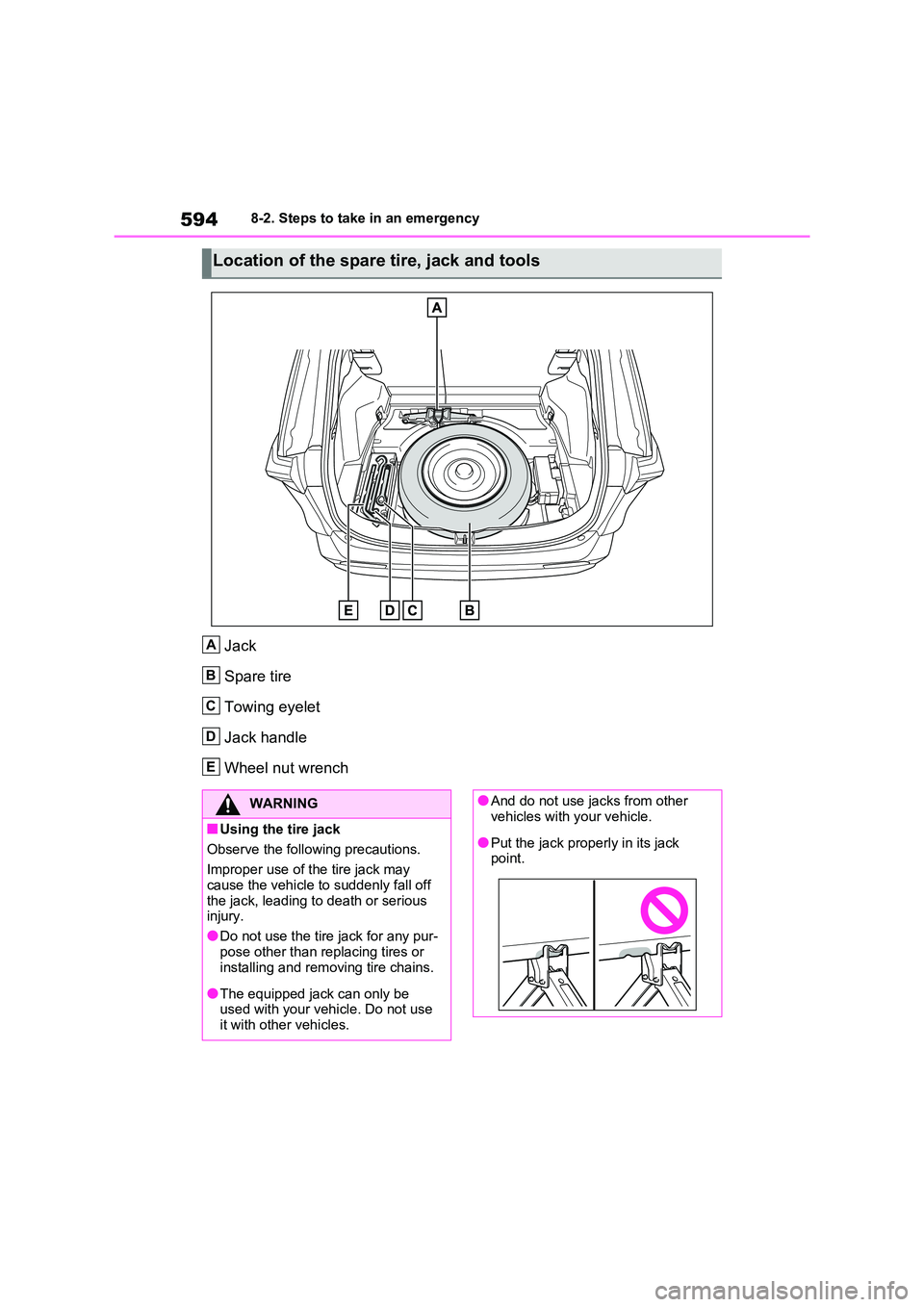
5948-2. Steps to take in an emergency
Jack
Spare tire
Towing eyelet
Jack handle
Wheel nut wrench
Location of the spare tire, jack and tools
A
B
C
D
E
WARNING
■Using the tire jack
Observe the following precautions.
Improper use of th e tire jack may
cause the vehicle to suddenly fall off
the jack, leading to death or serious injury.
●Do not use the tir e jack for any pur-
pose other than replacing tires or installing and removing tire chains.
●The equipped jack can only be used with your vehi cle. Do not use
it with other vehicles.
●And do not use j acks from other
vehicles with your vehicle.
●Put the jack properly in its jack
point.
Page 597 of 666
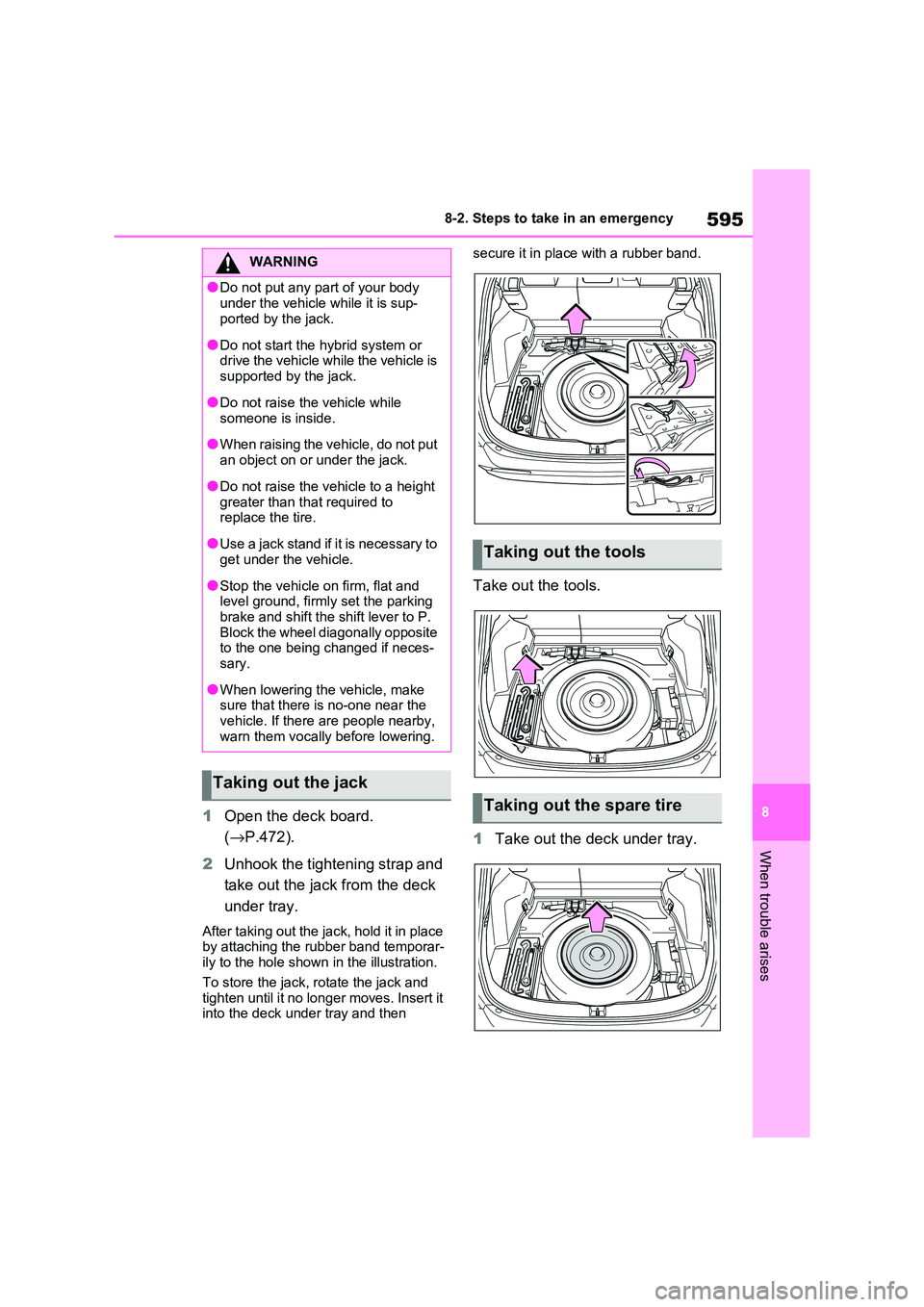
595
8
8-2. Steps to take in an emergency
When trouble arises
1 Open the deck board.
( →P.472).
2 Unhook the tightening strap and
take out the jack from the deck
under tray.
After taking out the jack, hold it in place
by attaching the r ubber band temporar- ily to the hole shown in the illustration.
To store the jack, rotate the jack and
tighten until it no longer moves. Insert it into the deck under tray and then
secure it in place with a rubber band.
Take out the tools.
1 Take out the deck under tray.
WARNING
●Do not put any part of your body
under the vehicle while it is sup-
ported by the jack.
●Do not start the h ybrid system or
drive the vehicle while the vehicle is supported by the jack.
●Do not raise the vehicle while
someone is inside.
●When raising the vehicle, do not put
an object on or under the jack.
●Do not raise the v ehicle to a height
greater than that required to replace the tire.
●Use a jack stand if it is necessary to get under the vehicle.
●Stop the vehicle on firm, flat and level ground, firml y set the parking
brake and shift the shift lever to P.
Block the wheel diagonally opposite to the one being changed if neces -
sary.
●When lowering the vehicle, make
sure that there is no-one near the
vehicle. If there a re people nearby, warn them vocally before lowering.
Taking out the jack
Taking out the tools
Taking out the spare tire
Page 598 of 666
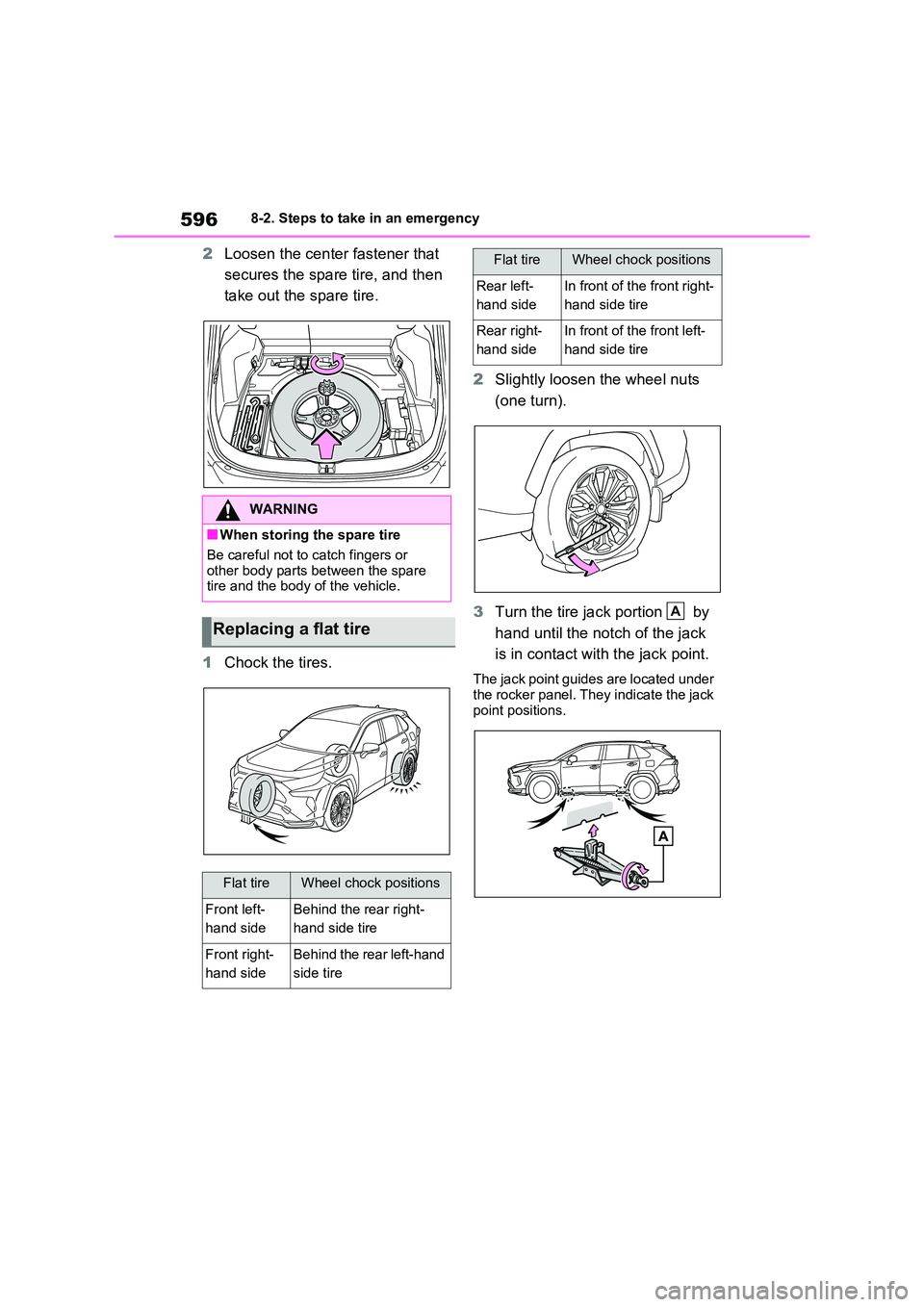
5968-2. Steps to take in an emergency
2Loosen the center fastener that
secures the spar e tire, and then
take out the spare tire.
1 Chock the tires.
2 Slightly loosen the wheel nuts
(one turn).
3 Turn the tire jack portion by
hand until the notch of the jack
is in contact with the jack point.
The jack point guides are located under
the rocker panel. They indicate the jack
point positions.
WARNING
■When storing the spare tire
Be careful not to catch fingers or
other body parts bet ween the spare tire and the body of the vehicle.
Replacing a flat tire
Flat tireWheel chock positions
Front left-
hand side
Behind the rear right-
hand side tire
Front right-
hand side
Behind the rear left-hand
side tire
Rear left-
hand side
In front of the front right-
hand side tire
Rear right-
hand side
In front of the front left-
hand side tire
Flat tireWheel chock positions
A
Page 599 of 666
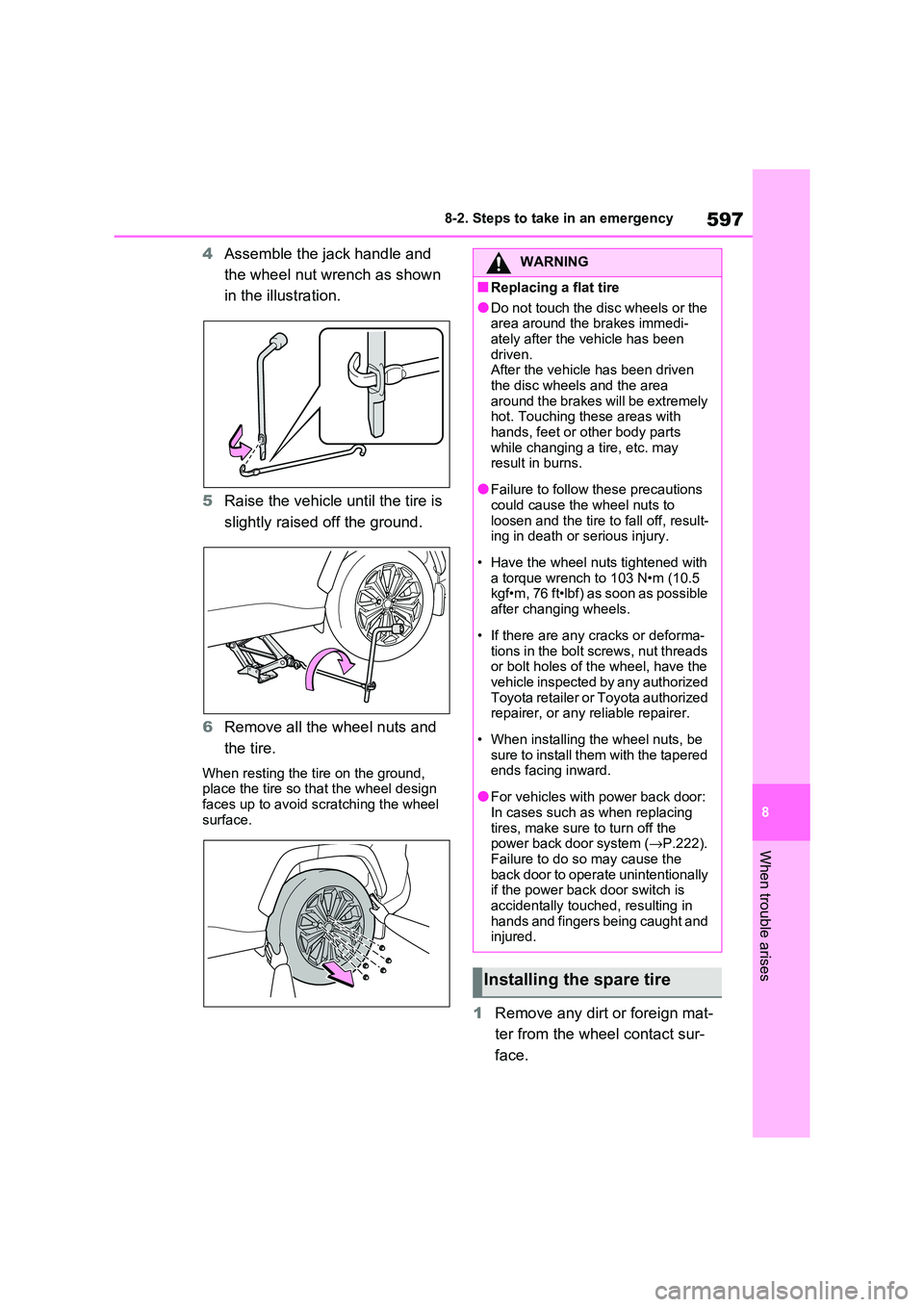
597
8
8-2. Steps to take in an emergency
When trouble arises
4 Assemble the jack handle and
the wheel nut wrench as shown
in the illustration.
5 Raise the vehicle until the tire is
slightly raised off the ground.
6 Remove all the wheel nuts and
the tire.
When resting the tire on the ground,
place the tire so that the wheel design
faces up to avoid sc ratching the wheel surface.
1 Remove any dirt or foreign mat-
ter from the wheel contact sur -
face.
WARNING
■Replacing a flat tire
●Do not touch the disc wheels or the
area around the brakes immedi - ately after the vehicle has been
driven.
After the vehicle has been driven the disc wheels and the area
around the brakes will be extremely
hot. Touching these areas with
hands, feet or other body parts while changing a tire, etc. may
result in burns.
●Failure to follow these precautions
could cause the wheel nuts to
loosen and the tire to fall off, result- ing in death or serious injury.
• Have the wheel nuts tightened with a torque wrench to 103 N•m (10.5
kgf•m, 76 ft•lbf) as soon as possible
after changing wheels.
• If there are any cracks or deforma-
tions in the bolt screws, nut threads or bolt holes of t he wheel, have the
vehicle inspected by any authorized
Toyota retailer or Toyota authorized repairer, or any reliable repairer.
• When installing the wheel nuts, be sure to install them with the tapered
ends facing inward.
●For vehicles with power back door:
In cases such as when replacing
tires, make sure to turn off the power back door system ( →P.222).
Failure to do so may cause the
back door to operate unintentionally if the power back door switch is
accidentally touched, resulting in
hands and fingers being caught and injured.
Installing the spare tire
Page 600 of 666
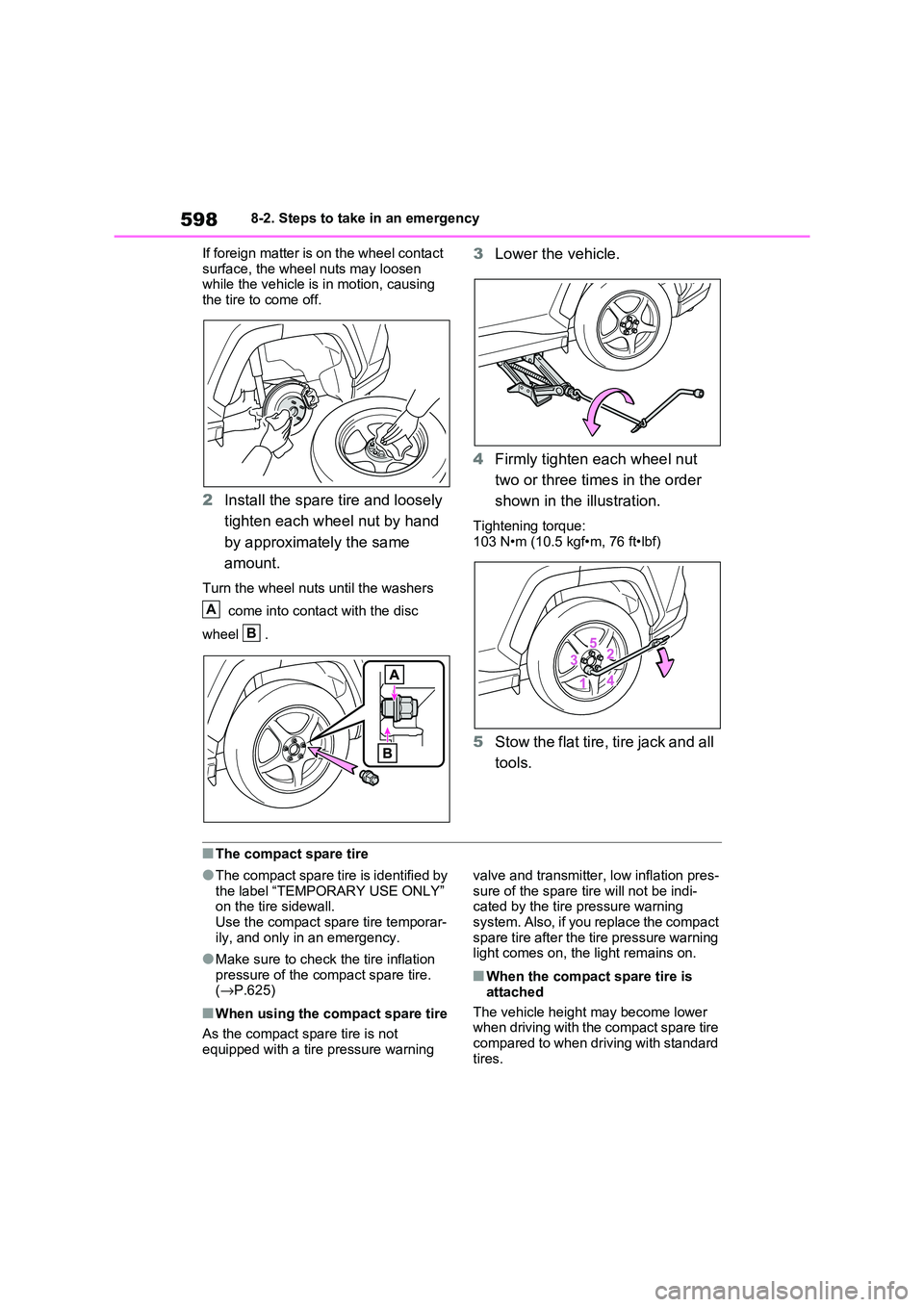
5988-2. Steps to take in an emergency
If foreign matter is on the wheel contact
surface, the whee l nuts may loosen while the vehicle is in motion, causing
the tire to come off.
2 Install the spare tire and loosely
tighten each wheel nut by hand
by approximately the same
amount.
Turn the wheel nuts until the washers
come into contact with the disc
wheel .
3 Lower the vehicle.
4 Firmly tighten each wheel nut
two or three times in the order
shown in the illustration.
Tightening torque: 103 N•m (10.5 kgf•m, 76 ft•lbf)
5 Stow the flat tire, tire jack and all
tools.
■The compact spare tire
●The compact spare tire is identified by
the label “TEMPORARY USE ONLY” on the tire sidewall.
Use the compact spar e tire temporar-
ily, and only in an emergency.
●Make sure to check the tire inflation
pressure of the compact spare tire. ( →P.625)
■When using the compact spare tire
As the compact spare tire is not
equipped with a tire pressure warning
valve and transmitter, low inflation pres -
sure of the spare tire will not be indi - cated by the tire pressure warning
system. Also, if you replace the compact
spare tire after the ti re pressure warning light comes on, the light remains on.
■When the compact spare tire is
attached
The vehicle height may become lower when driving with the compact spare tire
compared to when driving with standard
tires.
A
B